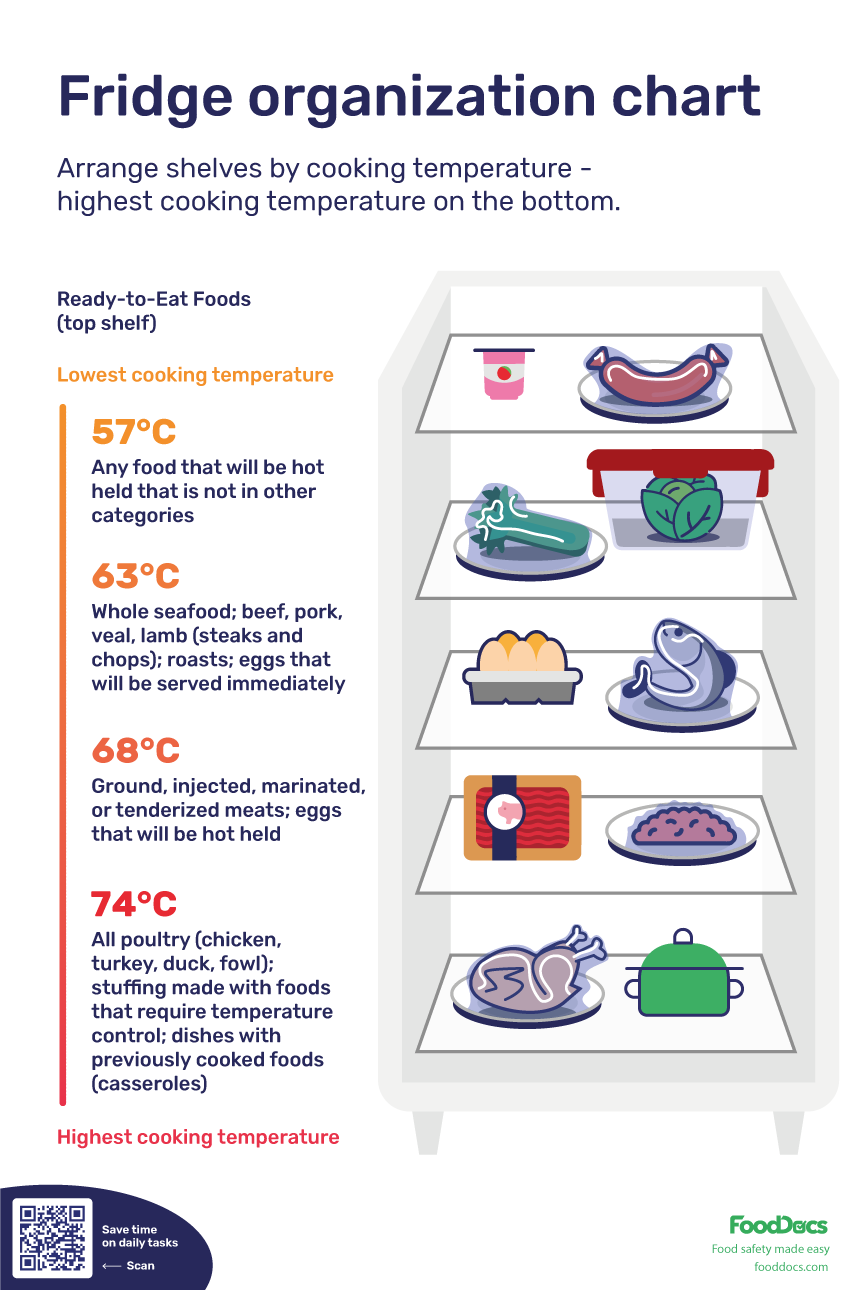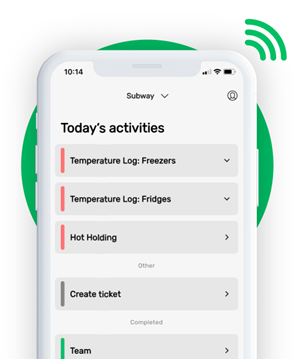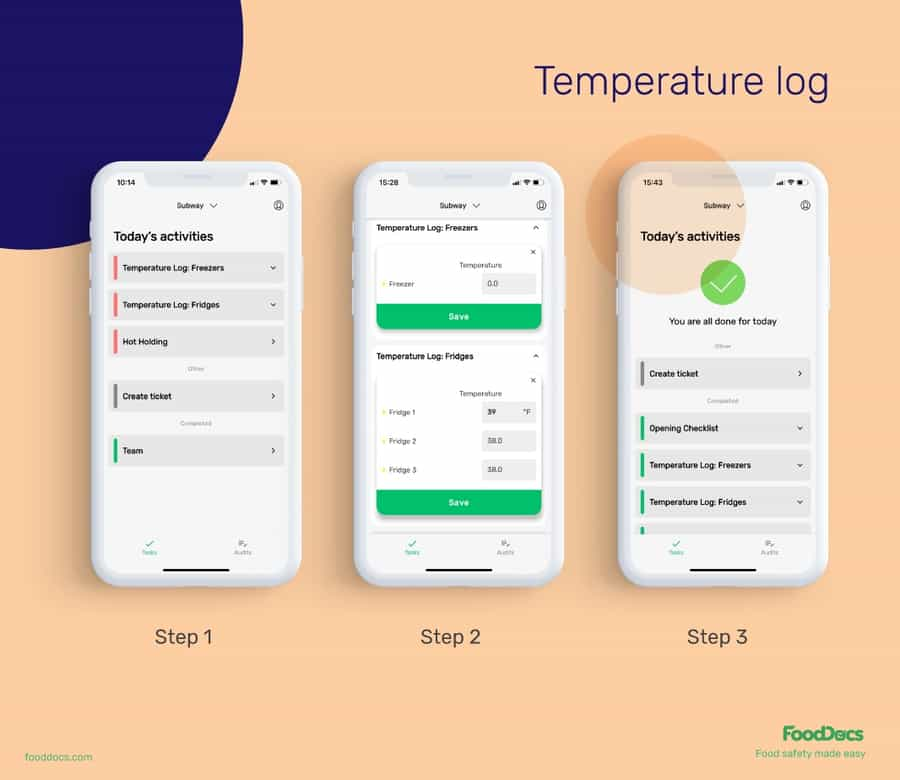FRIDGE ORGANIZATION CHART


This is how our Digital Food Safety platform saves 20% of your time on daily tasks:
- Get upcoming task notifications
- Add data into the app
- Check the status of tasks in real-time

When food safety was still handled on paper, I typically spent a couple of hours per day getting the papers and going around checking or completing tasks… Now I can sit down and it's just all there in one place. It takes me 5-10 minutes.
Ruth B.
Store Manager
Fridge organization chart
There is more to keeping foods in a refrigerator than just maintaining a proper temperature with a fridge thermometer. In terms of food safety, the proper arrangement of foods inside your fridge matters a lot and can help you prevent foodborne illnesses. The mere placement of your raw chicken cutlets, ground meats, cheese sticks, and fruits can significantly affect the safety of your other food products. Unless you have several refrigerators in your food establishment, you will need to understand and implement proper fridge organization to prevent cross-contamination in one refrigerator. What your team will need is a fridge organization chart.
While it is true that keeping foods chilled is a great way to prolong their shelf-life by controlling the growth of pathogens, the proper organization in a fridge can decide the fate of your material's food safety. Raw foods, cooked foods, and ready-to-eat TCS food must be properly organized inside a fridge to maintain safety. It's not enough that the temperature control of your fridge is consistently running correctly. As a food business owner, you are responsible for orienting and training your food safety team to properly stack foods inside the refrigerator.
In this article, find out the best way to help your food safety team remember proper fridge organization and monitor storage temperature; plus more food safety tips.
While it is true that keeping foods chilled is a great way to prolong their shelf-life by controlling the growth of pathogens, the proper organization in a fridge can decide the fate of your material's food safety. Raw foods, cooked foods, and ready-to-eat items must be properly organized inside a fridge to maintain safety. It's not enough that the temperature control of your fridge is consistently running correctly. As a food business owner, you are responsible for orienting and training your food safety team to properly stack foods inside the refrigerator.
In this article, find out the best way to help your food safety team remember proper fridge organization and monitor storage temperature.
What is a fridge organization chart?
A fridge organization chart is a visual guide for food handlers storing foods inside the refrigerator storage unit. Every kitchen fridge is composed of many shelf levels. These adjustable shelves or fridge drawers were not simply made to save space. They are also intended for organizing foods in the kitchen.
As important as it is in kitchens and households, organizing food products and raw materials in a fridge plays a significant role in keeping customers and family members safe. Improper grouping and order of foods increases the risk of cross-contamination, and therefore the risk of causing foodborne illnesses. This task is in addition to maintaining consistent temperatures and preventing temperature fluctuations in your fridge.
Imagine placing whole, raw meat on top of your fresh fruits and leafy greens. Raw meat juices and food residue can fall into the other raw products and fresh produce that will only require a very minimal cooking process. This may cause the unnecessary growth of microorganisms in other contaminated foods. The contaminated commercial product has a higher chance of causing food poisoning as soon as it is served to customers.
To prevent such occurrences, a fridge organization chart can be used to guide food handlers with proper food storage in a fridge. Download these storage instructions now for free and check out more food safety posters from FoodDocs.
Who needs a Fridge organization chart?
Ideally, if you have a refrigerator, you would find a fridge organization chart useful. That includes restaurants, food trucks, cafeterias, deli shops, grocery stores, and even institutional food establishments. Regardless of whether your fridge is small or an industrial-sized one, the organization of the foods inside it can help in keeping any fresh food safe all the time. Your fridge organization chart can be used to train food handlers in controlling foodborne microorganisms and avoiding serving harmful foods.

Why it's important at all to pay attention to the fridge's organization?
Any food establishment is expected to have many different dishes on its menu. This also means that there are a lot of diverse raw materials in every food service kitchen. To keep them safe and fresh for a prolonged time, an optimal storage environment involving storage at a low and safe temperature is necessary. Any raw product such as raw meat, raw poultry, dairy products, and any other highly perishable food with very limited shelf life must be stored in an airtight container and refrigerated to remain safe. To ensure this, kitchen thermometers must always be equipped in refrigerators.
Cold food temperature and proper humidity conditions are major factors for very slow bacterial growth and is considered as a method of food preservation. Their biological processes are slowed down and therefore prevent them from spoiling foods. Foods naturally have beneficial and pathogenic bacteria, along with other microorganisms on them. The amounts of bacteria will depend on the quality of raw materials. Harmful bacteria may lead to loss of quality and safety of foods, leading to more limited shelf life. As such, it is important to slow down the growth of these spoilage bacteria by keeping them out of ambient temperature or the temperature danger zone. Refrigerated temperatures with good air circulation are the optimal storage environment for fruits, meats, vegetables, and other fresh stock of raw ingredients.
In doing so, the cold temperature storage does not prevent the spread of pathogenic bacteria. A simple touch or drip of contaminated food from their raw juices to one that is ready to eat or prepared foods can cause cross-contamination. This is why food items are suggested to be pat dried with paper towels or any absorbent paper and stored in their original packaging or in an airtight container and properly grouped in clean refrigerator space.
In general, foods must be grouped according to their required degree of cooking. That is, foods that require thorough cooking such as ground beef, deli meat, poultry products, and leftover foods such as stew meats and other cooked meat in storage containers must be placed on the lowest shelf. On the middle shelf, different cuts of beef and pork, eggs, egg products, and raw fish are placed. Unless there is a frozen meat drawer, raw meats must be placed in clean, food-grade containers and grouped.
Lastly, ready-to-eat foods such as yogurt drinks and materials that require very minimal cooking such as any fresh fruit or vegetable, which are perishable products, in their original container or shallow dish are placed on the upper shelves. Beverage items are usually placed on the fridge door or together with ready-to-eat foods.
In such an arrangement, the possibility of fresh meat juices dripping into any other refrigerated food and spreading harmful bacteria becomes very low. This would also lead to less food spoilage and food waste. This is also the reason why meats must be stored in leak-proof proper packaging. Proper organization of foods help in rotation of ingredients to prevent reaching their best-before date and gives food handlers accessibility to items.
What are the benefits of a Fridge organization chart?
A fridge organization chart can become a very important part of your food safety management system. Not only can it serve as a reminder but it can also be used for basic food safety training for food handlers. The importance of refrigerator organization cannot be undermined and must be consistently performed every day. A simple mistake such as placing ground poultry or other frozen meats together with a pie at the top of the refrigerator shelf or fridge bins can potentially cause a foodborne illness outbreak.
Here are a few specific ways how a fridge organization chart can help your food business:
-
Food safety. As discussed, organizing your food items inside the refrigerator can help reduce the occurrence of cross-contamination and protect public health. Using a fridge organization chart, your employees can always be reminded of how to properly store food items. Place your chart on the fridge door for easy access.
-
Less food waste. When your variety of foods are kept fresh, the refrigerator clean, and food spoilage is prevented, the chances of accumulating food waste also become smaller. Spoiled foods may result from cross-contamination and can further spread if foods are improperly stacked. The proper organization also helps in the stock rotation of raw materials.
-
Cost-saving. The combined effects of less food waste and significantly reduced risk of food poisoning can save your food business from unnecessary expenses. At most, proper fridge organization can help you prevent any lawsuits as a result of causing foodborne illness in consumers.
-
Employee training. When your food handlers constantly see how foods must be stored in the refrigerator, the task becomes a part of their reflex and common knowledge. This can help them continuously do the operation even without reminding them repeatedly.
How to create a Fridge organization chart?
Making a fridge organization chart requires a few major factors for it to become effective. Your chart must not only have the necessary information related to the topic but the data must also be presented clearly to everyone. To guide you on how to create a fridge organization chart, consider the following:
-
Accurate. The information and arrangement of foods that you put in your cold storage chart must be based on approved and peer-reviewed information. The data you put will be used to maintain the safety of foods and therefore must contain factual information. Consult food safety agency databases and scientific journals in making your organization chart.
-
Updated. When gathering information, always check if the information is up-to-date. Food safety agencies and food scientists always come up with more efficient ways to maintain food safety and therefore, information can sometimes be changed without notice.
-
Clear. A fridge organization chart heavily relies on images. Using clear illustrations facilitates how food handlers translate and understand the information. If you use too many words and information, it will take food handlers more time to understand the chart. Use clear and easy-to-understand imagery and information. Your chart must also be placed in an obvious area such as freezer doors.
-
Applicable to your food business. Not all refrigerators are built alike. If you are making a fridge organization layout from scratch, consider adapting it to the fridge that you are using. What is important is that the principle of refrigerator organization is properly conveyed through the cold food storage chart. In addition, your chart may also include some additional freezer tips for any of your food service operator.
What is the easiest way to get a Fridge organization chart?
If you want a complete and accurate fridge organization chart, then download our ready-made and free, and printable freezer storage chart from FoodDocs now! This chart is only one of our many free tools at FoodDocs. We have created a collection of important food safety documents that can help food establishments maintain food safety.
In relation to keeping foods organized in your fridge, you can also use our temperature log sheet template. Use this monitoring form for recording the refrigerator temperature readings and help your food employees address any concerns on storage times for refrigerated food.
Visit our HACCP plan template hub for more!
How can I help my team keep in mind temperature monitoring?
While our free fridge organization chart can help you remember how to store foods correctly inside a refrigerator, it won't be of much use for monitoring all aspects of food storage temperature and keeping food cold. These two tasks go together to achieve food safety in your establishment. If one of them does not work well, the other may be insignificant in preventing contamination or spoilage.
To help you complement your fridge organization task, use our digital solution for correct temperature monitoring. With our digital solution, an accurate temperature monitoring system will never have to be a repetitive chore, nor will food handlers ever forget doing it. This digital solution can become an integral part of your cooked and raw food storage system for your team:
-
With our smart notification system, our system will send intuitive notifications through our mobile application. Your food employees will receive reminder alerts whenever the set time for monitoring your fridge temperature is near. This can also be used to remind food handlers of products nearing their expiration dates or use-by dates.
-
Digital monitoring log is equipped with an auto-fill feature that prefills the form for you and would only require verification. The information that our system uses for prefilling your temperature monitoring log is based on your previous data entries. With such a feature, you can save your employees time and allow them to focus on other food safety tasks. With our prefilling and notification features, you can save a significant amount of time and focus on other aspects of your food business.
-
You can get automatically generated monitoring forms such as cooking internal temperature logs, cleaning checklists, fridge temperature log forms, and more. You can easily monitor every separate storage unit with these forms.
-
A digital monitoring system can also help you as a manager:
- To help you achieve and maintain food safety compliance more effortlessly, our system will only require an average of 15 minutes of your time for setup. Within this period, our system will automatically generate a temperature monitoring log and several other food safety monitoring documents that you can use to record and ensure the constant temperature of your refrigerators and the safety of your whole food business. This log can also be used for monitoring cooking temperatures in particular periods of time.
- When you sign-up for our digital FSMS, you also get a real-time dashboard that can help you save at least 20% of your time supervising your team. You can use this feature to identify areas that need more improvement and attention.
- Cloud-storage enables to keep all food safety-related files digitally and easy to find.
All of these features are available through our digital Food Safety Management System. Maintaining food safety compliance through a digital platform has never been this easy. With the help of our system, you can confidently operate every day and serve high food quality products while maintaining public safety. Experience our product features firsthand by availing of our free, 14-day trial now.













